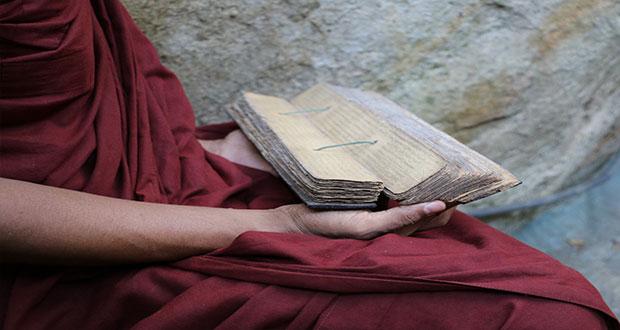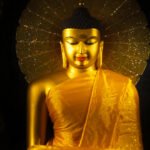“Dear bhikkhus, as long as there is no sun and moon, there is no light in this world, instead darkness prevails. There is complete darkness in the world. There is no recognition of day and night. There are neither months nor years nor seasons.
And once the sun and the moon appears in this world, from that day onwards there is light which penetrates the darkness. The complete darkness ceases. Days and nights can be discerned. Months and years and seasons can be seen.
In the same way, dear bhikkhus, as long as a supreme Buddha does not appear in this world, there is no light of Dhamma in this world; instead the darkness of Avijja prevails. There is no recognition of the four noble truths. There are no explanations of the four noble truths. There are no explications of the four noble truths. The meanings of the four noble truths are not expounded.
And once, when the lord Buddha appears in this world, the light of Dhamma penetrates the darkness. The darkness of Avijja ceases. The four noble truths are recognized. The four noble truths are explained in great detail. The four noble truths are explicated. The meanings are expounded.”
Dutiya suriya sutta of Saṃutta nikaya
In the previous two months, through this page, we learnt that there are four unalterable facts in this world and that they do not change under any circumstance. They are called the four noble truths. The first noble truth is Dukkhan ariyasaccaɱ – which means that there exists a suffering in this world, which cannot be wielded according to one’s wishes. Second noble truth is the Dukkhasamudayaṁ ariyasaccaṁ – the reason for the existence of the above mentioned suffering. The third noble truth is Dukkhanirodhaṁ ariyasaccaṁ – the cessation of suffering or being free from that suffering. The fourth noble truth is Dukkhanirodhagāminī paṭipadā ariyasaccaṁ – which is the path leading to the cessation of suffering or the way to be free from suffering.
We also learnt that revelation of these unalterable truths, that exist through-out time, can be done only by a lord Buddha. The Lord Buddha sheds light to this fact and reveals to the world, to gods and humans that there is such a phenomenon in this world. Every living being, in every realm, suffers because of their unawareness of these truths. The Lord Buddha upon attaining the supreme enlightenment realizes these Four Noble Truths and reveals it to the world. Lord Buddha perfected his life over a time span of uncountable eons with the sole intention of realizing this unprecedented truth of life.
We first learned the noble truth of suffering –‘Dukkhan ariya saccan’. And we learned what the Lord Buddha explained as suffering. If we recall that, throughout our lives we experience birth, ageing, sickness, death, grief, lamentation, unbearable physical suffering, misery or mental suffering, tiredness or the despondency, having to associate with what we dislike, having to disassociate with what we like, pain that comes when we do not get what we want. These are the conditions of suffering that we are subjected to. And finally, the lord Buddha expounded, in brief, the five aggregates of clinging as suffering.
Next we learnt the second noble truth; Dukkha Samudhaya Ariya Sacca – the reason behind all the suffering is tanha; desire or craving. We learnt that there are three types of tanha; desire for sensual pleasures (kāma taṇhā), desire for existence (bhava taṇhā), desire to exist without the existence (vibhava taṇhā). And it has some distinct qualities that can make a living being be bound to existence, and to suffering.
Today we will learn the third noble truth; dukkhanirodhaṃ ariyasaccaɱ, the cessation of suffering. Through this noble truth, the lord Buddha explicates that there is an end to this suffering. Don’t you feel happy and relieved just by hearing it?
“Katamañca bhikkhave dukkhanirodho ariyasaccaɱ: yo tassāyeva taṇhāya asesavirāganirodho cāgo paṭinissaggo mutti anālayo.
What is, dear bhikkhus, the noble truth of cessation of suffering: it is the complete cessation of that very desire without retainment, ending the attachment to it, relinquishing it, liberating oneself from it, and detaching oneself from it.”
According to Maha Sati Patthana sutta of Deegha nikaya we learnt that tanha, desire arises in things that are pleasurable and joyful in this world. Therefore, if tanha, desire is to cease, it should cease in the very place it arises; in things that are pleasurable and joyful in this world.
What are pleasurable things in the world?
The eye is a pleasurable and joyful thing. Hence desire will cease with the cessation of “our desire for the eye”.
The forms, the things we see with the eyes are pleasurable and joyful things in the world. Hence desire will cease with the cessation of “our desire for the things we see”.
The consciousness that arises in the eye is a pleasurable and joyful thing. Hence desire will cease with the cessation of “our desire for the consciousness”.
The coming together of the eye, the forms and the eye-consciousness; eye-contact is a pleasurable and joyful thing. Hence desire will cease with the cessation of “our desire for eye-contact”.
The feeling which arises due to eye-contact is a pleasurable and joyful thing. Hence desire will cease with the cessation of “our desire for feeling which arises due to eye-contact”.
Recognizing or acknowledging what you see; perception of forms is a pleasurable and joyful thing. Hence desire will cease with the cessation of “our desire for perception of forms”.
The thoughts that arise as a result of seeing and recognizing something or someone are pleasurable and joyful in this world. Hence desire will cease with the cessation of “our desire for thoughts that arise as a result of seeing and recognizing something or someone”.
The craving, wanting, greed which arises for things we see with our eyes are pleasurable and joyful thing. Hence desire will cease with the cessation of “our desire for the craving, wanting, greed which arises for things we see with our eyes”.
Repeatedly thinking of what we saw is a pleasurable and joyful thing. Hence desire will cease with the cessation of “our repeated thinking of what we saw”.
The same is true for other sense faculties; ear, nose, tongue, body and mind. If desire ceases, it ceases in these places.
Therefore, we can see that desire ends in the very places it originated from. The solution for suffering is to be free from desire, to let go of desire, to abandon desire. The most compassionate Buddha compared relinquishing desire to Nibbana in Radha saṃutta of Saṃutta nikaya;
“Tanhakkhayo hi Radha, nibbanan”
This is a revelation of Lord Buddha that many find hard to come to terms with, Since we are accustomed to the notion that pleasurable things bring “pleasure”, we instinctively repel the idea of them been the cause of suffering. Let us consider this for a moment;
Think about someone you love most. What if that person dies right now? You will be grief stricken; you don’t even want to think about it. Now think about a person you have no special attachment. What if that person dies right now? Is your grief similar to the grief which arose by the thought of your loved one dying? No, it is no-where near isn’t it? The more you desire the more sorrow it will bring. The most compassionate Buddha said, if a person has 100 things he likes, he has 100 sufferings. If he has 99 things then he would have 99 sufferings… if he has 1 thing he has 1 suffering. If he has nothing he likes, he has no suffering.
However one cannot just let go of the desire for all the pleasurable things we listed above, because desire arise with a reason. The reason for desire is ignorance; the failure to comprehend the Four Noble Truths. Hence to eradicate desire by dispelling ignorance one has to follow the noble path leading to the cessation of suffering; dukkhanirodhagāminī paṭipadā ariyasaccaṁ, which we will discuss next month.
By Prajapathi Jayawardena













Recent Comments